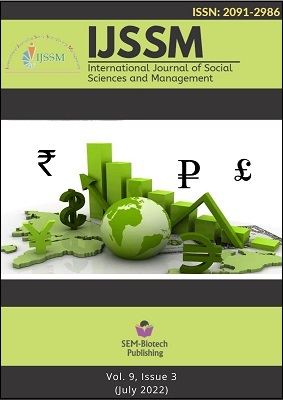Production Economics and Determinants for Adoption of Commercial Vegetable Production in Kathmandu Nepal
DOI:
https://doi.org/10.3126/ijssm.v9i3.47032Keywords:
Binary logistic, factors, gross margin, variable costAbstract
The vegetable sub-sector is considered a sector having high prospects of commercialization. It supports to create the job opportunities, thereby contributes to reducing the poverty rate. However, little empirical research has been done to know the benefits of commercial production and households’ behavior towards its adoption. Thus, this study seeks to assess the production economics and determinant factors of farmers for the adoption of commercial vegetable production in Kathmandu district, Nepal. In total 199 households were selected using a stratified random sampling technique. The primary data were collected from January to February 2022. The descriptive statistics, benefit-cost ratio, and binary logistic regression were applied for data analysis using SPSS. The results reveal that the gross margin and benefit-cost ratio of commercial vegetable farming were found to be NRs. 533,130/ha and 3.23 respectively, which were higher than the subsistence vegetable farming (gross margin NRs. 419, 031/ha and benefit to cost ratio 2.49). Further, the findings of binary logistic regression show that age, education of household head, experience, type of family, membership, and access to credit were significantly important determinants of commercial vegetable production. Therefore, any agricultural development programs such as financial services, business training, and encourage farmers to join into cooperatives could be instrumental for commercial vegetable farming.
Int. J. Soc. Sc. Manage. Vol. 9, Issue-3: 103-112
Downloads
Downloads
Published
How to Cite
Issue
Section
License
Copyright (c) 2022 International Journal of Social Sciences and Management

This work is licensed under a Creative Commons Attribution-NonCommercial 4.0 International License.
This license enables reusers to distribute, remix, adapt, and build upon the material in any medium or format for noncommercial purposes only, and only so long as attribution is given to the creator.




